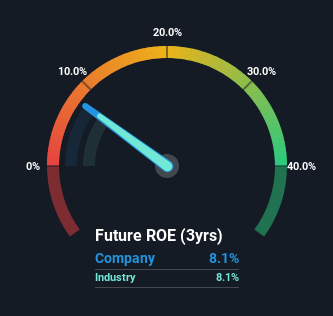Does Essential Utilities, Inc. (NYSE:WTRG) Create Value For Shareholders?
Does Essential Utilities, Inc. (NYSE:WTRG) Create Value For Shareholders?
Many investors are still learning about the various metrics that can be useful when analysing a stock. This article is for those who would like to learn about Return On Equity (ROE). By way of learning-by-doing, we'll look at ROE to gain a better understanding of Essential Utilities, Inc. (NYSE:WTRG).
许多投资者仍在学习分析股票时可能有用的各种指标。本文适用于那些想了解股本回报率(ROE)的人。通过边干边学的方式,我们将研究投资回报率,以更好地了解基本公用事业公司(纽约证券交易所代码:WTRG)。
ROE or return on equity is a useful tool to assess how effectively a company can generate returns on the investment it received from its shareholders. In other words, it is a profitability ratio which measures the rate of return on the capital provided by the company's shareholders.
投资回报率或股本回报率是评估公司如何有效地从股东那里获得投资回报的有用工具。换句话说,它是衡量公司股东提供的资本回报率的盈利比率。
Check out our latest analysis for Essential Utilities
查看我们对基本实用程序的最新分析
How Is ROE Calculated?
ROE 是如何计算的?
The formula for return on equity is:
股本回报率的公式是:
Return on Equity = Net Profit (from continuing operations) ÷ Shareholders' Equity
股本回报率 = 净利润(来自持续经营业务)÷ 股东权益
So, based on the above formula, the ROE for Essential Utilities is:
因此,根据上述公式,基本公用事业的投资回报率为:
8.1% = US$478m ÷ US$5.9b (Based on the trailing twelve months to September 2023).
8.1% = 4.78亿美元 ÷ 59亿美元(基于截至2023年9月的过去十二个月)。
The 'return' is the amount earned after tax over the last twelve months. One way to conceptualize this is that for each $1 of shareholders' capital it has, the company made $0.08 in profit.
“回报” 是过去十二个月的税后收入。将其概念化的一种方法是,公司每拥有1美元的股东资本,就会获得0.08美元的利润。
Does Essential Utilities Have A Good Return On Equity?
基本公用事业有不错的股本回报率吗?
By comparing a company's ROE with its industry average, we can get a quick measure of how good it is. The limitation of this approach is that some companies are quite different from others, even within the same industry classification. You can see in the graphic below that Essential Utilities has an ROE that is fairly close to the average for the Water Utilities industry (8.1%).
通过将公司的投资回报率与其行业平均水平进行比较,我们可以快速衡量其表现如何。这种方法的局限性在于,有些公司与其他公司有很大不同,即使在相同的行业分类中也是如此。你可以在下图中看到,基本公用事业的投资回报率与水务行业的平均水平(8.1%)相当接近。

So while the ROE is not exceptional, at least its acceptable. While at least the ROE is not lower than the industry, its still worth checking what role the company's debt plays as high debt levels relative to equity may also make the ROE appear high. If so, this increases its exposure to financial risk. Our risks dashboardshould have the 3 risks we have identified for Essential Utilities.
因此,尽管投资回报率并不例外,但至少是可以接受的。尽管至少投资回报率不低于该行业,但仍值得检查该公司的债务起了什么作用,因为相对于股权的高债务水平也可能使投资回报率显得很高。如果是这样,这会增加其金融风险敞口。我们的风险仪表板应包含我们为基本公用事业确定的三种风险。
How Does Debt Impact ROE?
债务如何影响投资回报率?
Companies usually need to invest money to grow their profits. The cash for investment can come from prior year profits (retained earnings), issuing new shares, or borrowing. In the case of the first and second options, the ROE will reflect this use of cash, for growth. In the latter case, the debt required for growth will boost returns, but will not impact the shareholders' equity. In this manner the use of debt will boost ROE, even though the core economics of the business stay the same.
公司通常需要投资来增加利润。投资现金可以来自上一年的利润(留存收益)、发行新股或借款。对于第一和第二种选择,投资回报率将反映这种对现金增长的使用。在后一种情况下,增长所需的债务将提高回报,但不会影响股东权益。通过这种方式,尽管企业的核心经济保持不变,但债务的使用将提高投资回报率。
Essential Utilities' Debt And Its 8.1% ROE
基本公用事业的债务及其8.1%的投资回报率
It's worth noting the high use of debt by Essential Utilities, leading to its debt to equity ratio of 1.15. The combination of a rather low ROE and significant use of debt is not particularly appealing. Debt increases risk and reduces options for the company in the future, so you generally want to see some good returns from using it.
值得注意的是,基本公用事业公司大量使用债务,导致其负债权益比率为1.15。相当低的投资回报率和大量使用债务相结合并不是特别有吸引力。债务会增加风险,减少公司未来的选择,因此您通常希望从使用债务中获得丰厚的回报。
Conclusion
结论
Return on equity is a useful indicator of the ability of a business to generate profits and return them to shareholders. Companies that can achieve high returns on equity without too much debt are generally of good quality. If two companies have around the same level of debt to equity, and one has a higher ROE, I'd generally prefer the one with higher ROE.
股本回报率是衡量企业创造利润并将其返还给股东的能力的有用指标。能够在不负债过多的情况下获得高股本回报的公司通常质量很好。如果两家公司的债务与股权比率大致相同,而一家公司的投资回报率更高,那么我通常更喜欢投资回报率更高的那家公司。
But ROE is just one piece of a bigger puzzle, since high quality businesses often trade on high multiples of earnings. The rate at which profits are likely to grow, relative to the expectations of profit growth reflected in the current price, must be considered, too. So you might want to take a peek at this data-rich interactive graph of forecasts for the company.
但是投资回报率只是更大难题中的一部分,因为高质量的企业通常以高倍的收益进行交易。还必须考虑利润可能增长的速度,相对于当前价格所反映的利润增长预期。因此,你可能想看看这张数据丰富的公司预测交互式图表。
But note: Essential Utilities may not be the best stock to buy. So take a peek at this free list of interesting companies with high ROE and low debt.
但请注意:基本公用事业可能不是最值得购买的股票。因此,来看看这份投资回报率高、债务低的有趣公司的免费清单。
Have feedback on this article? Concerned about the content? Get in touch with us directly. Alternatively, email editorial-team (at) simplywallst.com.
This article by Simply Wall St is general in nature. We provide commentary based on historical data and analyst forecasts only using an unbiased methodology and our articles are not intended to be financial advice. It does not constitute a recommendation to buy or sell any stock, and does not take account of your objectives, or your financial situation. We aim to bring you long-term focused analysis driven by fundamental data. Note that our analysis may not factor in the latest price-sensitive company announcements or qualitative material. Simply Wall St has no position in any stocks mentioned.
对这篇文章有反馈吗?对内容感到担忧?直接联系我们。 或者,给编辑团队 (at) simplywallst.com 发送电子邮件。
Simply Wall St的这篇文章本质上是笼统的。我们仅使用公正的方法根据历史数据和分析师的预测提供评论,我们的文章无意作为财务建议。它不构成买入或卖出任何股票的建议,也没有考虑到您的目标或财务状况。我们的目标是为您提供由基本数据驱动的长期重点分析。请注意,我们的分析可能不考虑最新的价格敏感型公司公告或定性材料。简而言之,华尔街没有持有任何上述股票的头寸。

 The formula for return on equity is:
The formula for return on equity is: